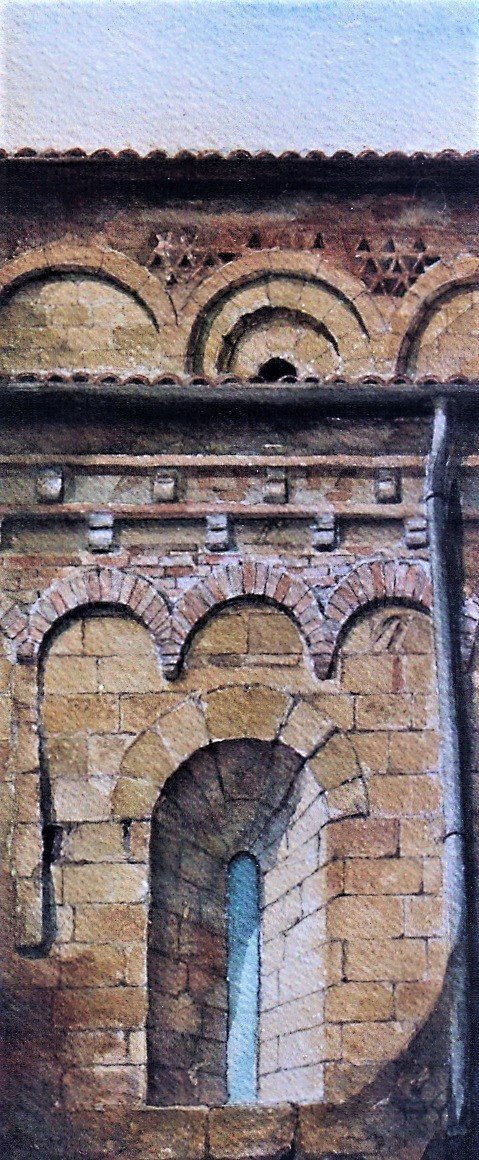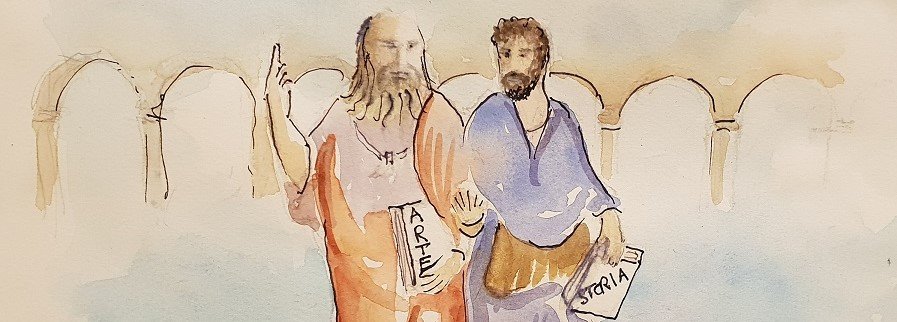
antiche geometrie architettoniche
ancient architectural geometries

2 0 1 0
watercolor on paper

Italiano
Dopo l'anno Mille, in Italia e in Europa cresce un fermento religioso parallelamente ad una affermazione concreta della propria esistenza, tutto in funzione di una nuova fede.
L'uomo medievale, terrorizzato dalla fine del mondo prevista per il Mille, che non avvenne, lentamente generò uno spirito di prima rinascita dapprima in Francia poi in Italia seguito dal resto d'Europa.
La Francia e l'Italia fecero da capofila nella costruzione di migliaia di edifici destinati al culto cattolico, ogni paese o città doveva possedere una chiesa per accogliere fedeli sempre più in crescita in seguito allo sviluppo delle tecniche di agricoltura che favorirono la ripopolazione delle campagne.
Spesso oltre alle città anche i paesini più piccoli facevano a gara per chi avesse la chiesa più bella, e si svilupparono così nuove tecniche di costruzione destinate ad abbellire le facciate, che dovevano restituire a Dio la bellezza del mondo esteriore.
I materiali per la costruzione furono sempre estratti nelle cave o nei terreni limitrofi, quindi una caratteristica ben definita di distinzione fra una chiesa piuttosto che un'altra.
Si usarono pietre di vari tagli e colori, tufo di ogni periodo geologico, argille di diverse tipologie dei terreni, cotte o crude e tutto questo determinerà le grandi differenze cromatiche, dei materiali e delle forme nelle chiese romaniche europee.
La grande fantasia e perizia tecnica dei costruttori del periodo 1000/1200 e la tipicità dei materiali usati, viene evidenziata in questo mio dipinto ad acquarello di uno scorcio di facciata di chiesa romanica.
Vediamo un uso della pietra tufacea viva, senza marmi e intarsi, per abbellire la facciata non ci sono cornici o lesene, ma solo tufo e mattoni in argilla.
Una meravigliosa scenografia architettonica di grande qualità con diversi giochi geometrici realizzati con la stessa pietra di tufo e mattoncini cotti.
Bellezze e sobrietà del Romanico.
Primi veri esempi di costruzioni a chilometro zero.
Un abbraccio da Armando.


English
After the year one thousand, in Italy and in Europe a religious ferment grows parallel to a concrete affirmation of one's own existence, all in function of a new faith.
The medieval man, terrified by the end of the world planned for the Thousand, which did not happen, slowly generated a spirit of first rebirth first in France then in Italy followed by the rest of Europe.
France and Italy were the leaders in the construction of thousands of buildings for Catholic worship, each country or city had to own a church to accommodate increasingly growing faithful as a result of the development of farming techniques that encouraged the repopulation of the countryside.
Often in addition to cities, even the smallest villages competed for those who had the most beautiful church, and so developed new construction techniques designed to embellish the facades, which had to restore to God the beauty of the outer world.
The construction materials were always extracted in the quarries or in the surrounding land, so a well-defined feature of distinction between one church rather than another.
We used stones of various cuts and colors, tuff of every geological period, clays of different types of terrains, cooked or raw and all this will determine the great chromatic differences, of the materials and shapes in the European Romanesque churches.
The great imagination and technical expertise of the builders of the period 1000/1200 and the typicality of the materials used, is highlighted in this my watercolor painting of a glimpse of a façade of Romanesque church.
We see a use of living tufa stone, without marbles and inlays, to embellish the façade there are no cornices or pilasters, but only tuff and clay bricks.
A marvelous architectural scenography of great quality with different geometric games made of the same tufa stone and fired bricks.
Beauties and sobriety of the Romanesque.
First real examples of zero-kilometer constructions.
A hug from Armando.
Fonti in italiano:
Umberto Eco
Jack Le Goff





discovery-it
@discovery-it

Vieni a trovarci sulla prima rivista dedicata al mondo dell'arte&storia

